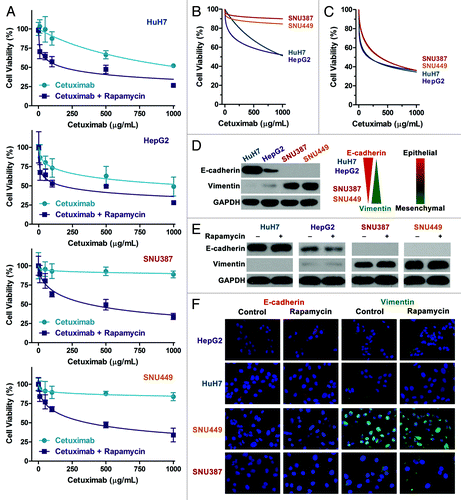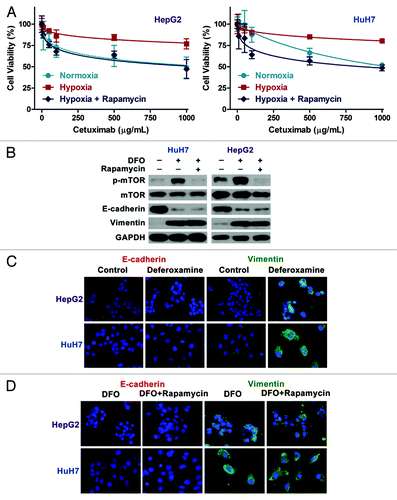Figures & data
Figure 1. Differential cetuximab sensitization by rapamycin in hepatocellular carcinoma cell lines. (A) Cell viability assays show that rapamycin sensitizes HepG2, HuH7, SNU-387, and SNU 449 cells to cetuximab. Cetuximab sensitivity to hepatoma cells (B) without or (C) with rapamycin cotreatment were obtained from (A). (D) Western blotting analysis of E-cadherin and vimentin expression characterizes epithelial or mesenchymal phenotypes in different human hepatocellular carcinoma (HCC) cells. Rapamycin treatment does not alter E-cadherin or vimentin expression (E) or localization (F) in HCC cells.

Figure 2. Basal mTOR activity in hepatoma cells. (A) Basal mTOR activity (p-mTOR expression) differs between epithelial and mesenchymal cells. (B) Rapamycin treatment attenuates p-mTOR expression in SNU-387 and SNU-449 cells.

Figure 3. Rapamycin restores cetuximab sensitivity following TSC2 knockdown. (A) Cell viability assays show that TSC2 silencing increases resistance to cetuximab and that rapamycin cotreatment restores cetuximab sensitivity. (B) Levels of mTOR activity, E-cadherin and vimentin expression, and (C) E-cadherin and vimentin subcellular localization in TSC2-silenced HepG2 and HuH7 cells with or without rapamycin treatment.

Figure 4. Rapamycin restores cetuximab sensitivity following hypoxia-induced EMT. (A) Cell viability assays show that hypoxia-induced EMT increases resistance to cetuximab and that cetuximab sensitivity is restored by rapamycin cotreatment. Levels of mTOR activity, E-cadherin, and vimentin expression, (B) and E-cadherin and vimentin subcellular localization (C and D) in HepG2 and HuH7 cells undergoing EMT with or without rapamycin treatment.

